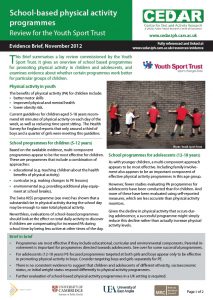Review for the Youth Sport Trust – November 2012
This Brief summarises a lay review commissioned by the Youth Sport Trust. It gives an overview of school based programmes for promoting physical activity in children and adolescents, and examines evidence about whether certain programmes work better for particular groups of children.
Jump to:
- Physical activity in youth
- School programmes for children
- School programmes for adolescents
- Do different approaches work for different groups?
- Successful programmes for children
- Successful programmes for adolescents
- Key references and resources.
Brief in brief
- Programmes are most effective if they include educational, curricular and environmental components. Parental involvement is important for programmes directed towards adolescents. See below for examples of successful programmes.
- For adolescents (12-18 years), PE-focused programmes targeted at both girls and boys appear only to be effective in promoting physical activity in boys. Consider targeting boys and girls separately.
- There is no consistent evidence to suggest that children and adolescents of different ethnicity, socioeconomic status, or initial weight status respond differently to physical activity programmes.
- Further evaluation of school-based physical activity programmes in a UK setting is required.
Physical activity in youth
The benefits of physical activity (PA) for children include:
- better motor skills
- improved physical and mental health
- lower obesity risk.
Current guidelines for children aged 5-18 years recommend 60 minutes of physical activity on each day of the week, as well as reducing time spent sitting. The Health Survey for England 2010 reports that only around a third of boys and a quarter of girls were meeting this guideline.
School programmes for children (5-12 years)
Based on the available evidence, multi-component programmes appear to be the most effective for children. These are programmes that include a combination of approaches:
- educational (e.g. teaching children about the health benefits of physical activity)
- curricular (e.g. making changes to PE lessons)
- environmental (e.g. providing additional play equipment at school breaks).
The Swiss KISS programme (see below) has shown that a substantial rise in physical activity during the school day may be enough to raise total physical activity. Nevertheless, evaluations of school-based programmes should look at the effect on total daily activity to discover if children are compensating for increased PA during school time by being less active at other times of the day.
School programmes for adolescents (12-18 years)
As with younger children, a multi-component approach appears to be most effective. Including family involvement also appears to be an important component of effective physical activity programmes in this age group.
However, fewer studies evaluating PA programmes for adolescents have been conducted than for children. And more of these have been evaluated using self-reported measures, which are less accurate than physical activity monitors.
Given the decline in physical activity that occurs during adolescence, a successful programme might simply reduce this decline rather than actually increase physical activity levels.
Do different approaches work for different groups?
For adolescents, programmes that include a PE component should be targeted at boys and girls separately. Evidence shows that when targeted at both girls and boys together, they are only effective in promoting physical activity in boys. However, programmes with a PE component increase physical activity in girls where they have been targeted alone.
However, this difference in effect is particular to the PE component. The ICAPS programme (see below), which did not include this, found no difference between boys and girls.
In contrast, from the available evidence, physical activity programmes in children under 12 years do not appear to have different effects on boys and girls.
There is no consistent evidence to suggest that children and adolescents of different ethnicity, socioeconomic status, or initial weight status respond differently to school-based physical activity programmes. However, those with lower initial physical activity levels do often respond better to programmes.
Further work in a UK setting is needed to confirm many of these observations as they are largely based on US and European populations. For evaluation resources, visit: www.mrc-epid.cam.ac.uk/resources/
Evidence on successful programmes
Successful programmes for children
- GreatFun2Run programme, England, 7-11 year olds. Included CD of resources for teachers; events to give children a goal for increasing physical activity; interactive website www.greatfun2run.org; local media campaign; summer activity wall planner. www.ncbi.nlm.nih.gov/pubmed/19154622; www.ncbi.nlm.nih.gov/pubmed/21767356
- Switch-Play programme, Australia, 10 year olds. 3 programmes evaluated, including various combinations of lessons on Behavioural Modification, lessons on Fundamental Movement Skills, and parental info and support. www.ncbi.nlm.nih.gov/pubmed/18253162
- KISS Programme, Switzerland, 6 & 11 year olds. Included specialist-delivered PE programmes; physical activity breaks to academic lessons; physical activity homework. www.ncbi.nlm.nih.gov/pmc/articles/PMC282771
Successful programmes for adolescents
- ICAPS, France, 4 year programme: 11-16 year olds. Included changing knowledge and attitudes through information and debate; encouraging social support from parents, peers and others; improving environmental conditions for physical activity. www.ncbi.nlm.nih.gov/pubmed/16523185
- Haerens et al, Belgium, 11-15 year olds. Included improving opportunities for physical activity during breaks and after school; sports material provided to schools; promotion of physical activity in class including feedback on individual fitness; information to parents; food component to increase healthy choices. www.ncbi.nlm.nih.gov/pubmed/17321427
Key references and resources
- Download a pdf of this Evidence Brief
- Download the full document School-based Physical Activity Programmes by Dr Alison McMinn
- See also Evidence Brief: Supporting physical activity in schools – Findings from the SPEEDY study
- NICE Guidance for Physical Activity in Children and Young People 2009
- Chief Medical Officers’ physical activity guidelines for young people 2011
Please cite this Evidence Brief as: UKCRC Centre for Diet and Activity Research (CEDAR), Evidence Brief 2: school-based physical activity programmes – Review for the Youth Sport Trust – November 2012. www.mrc-epid.cam.ac.uk/resources/policy-resources/evidence-briefs/eb-yst-web/

 MRC Epidemiology Unit
MRC Epidemiology Unit